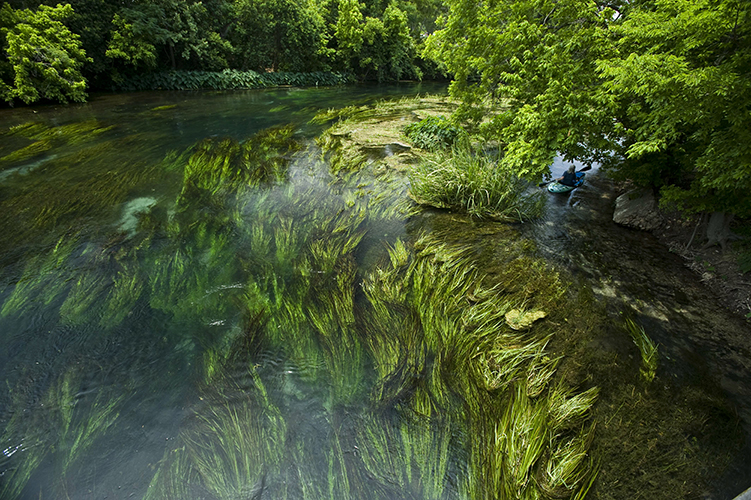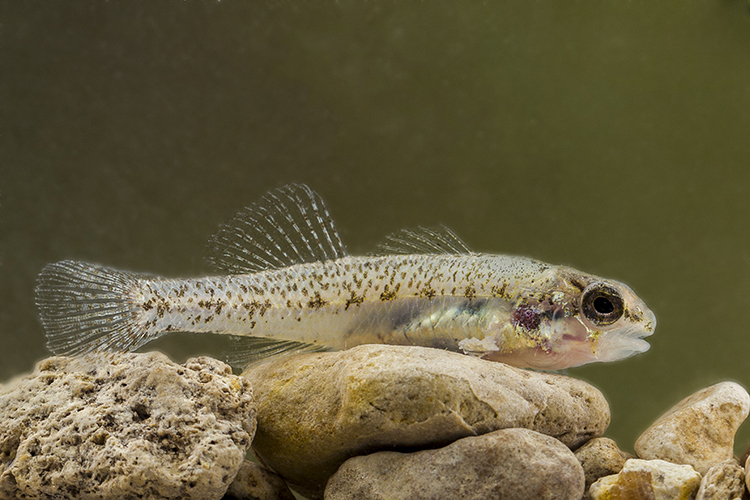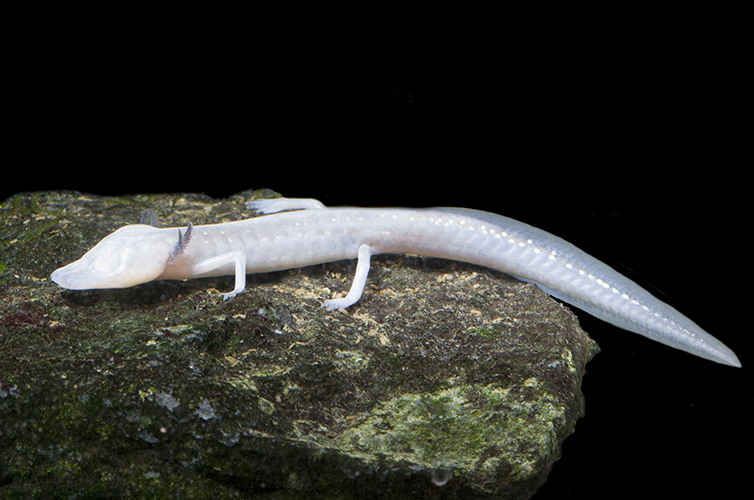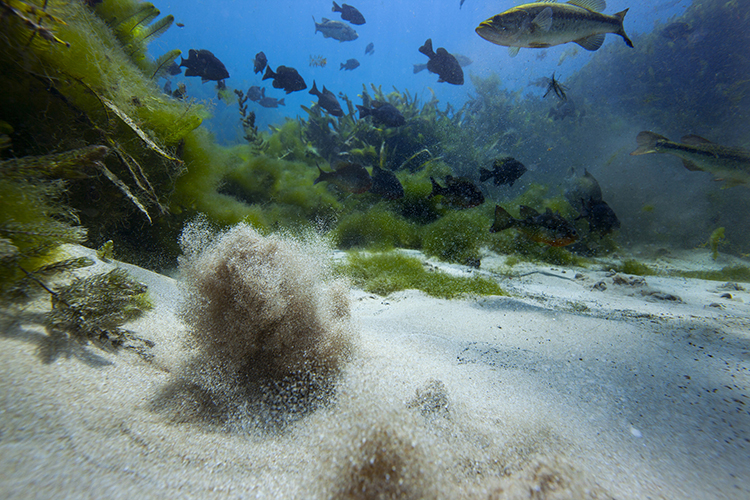Endangered Species found in the Edwards Aquifer System
Posted on May 15, 2025 by Brianna Anzaldua

Texas Wild Rice
Endangered Species Day, observed annually on the third Friday in May, is a national call to reflect on the plants and animals at risk of disappearing forever. It encourages awareness, and education to protect endangered and threatened species—not only for their uniqueness, but for the essential roles they play in maintaining healthy, functioning ecosystems.
In Central Texas, some of the world’s rarest endangered species live hidden beneath our feet, deep within the Edwards Aquifer and its spring systems. These species are more than just rare—they are indicators of groundwater health. Their survival depends on clean, stable springflow and intact habitats. In turn, they alert us to changes in the aquifer that could affect the water millions of people rely on.
Every species, no matter how small or hidden, has an important role to play. Some pollinate plants, others control insect populations, and many—like those in the aquifer—serve as early warning signs of environmental stress. The loss of even one species can disrupt the delicate balance of an ecosystem, threatening not just biodiversity, but also the natural resources we depend on.
This Endangered Species Day, we invite you to explore the underground world of the Edwards Aquifer and learn how protecting these hidden species helps protect us all.
In 2013, the Edwards Aquifer Authority (EAA) and several regional partners launched the EAHCP, a science-based plan to protect endangered species that rely on the Edwards Aquifer and nearby springs, like those in San Marcos and New Braunfels. The EAHCP protects seven endangered species, each with its own story, struggles, and importance.
Endangered Species of the Edwards Aquifer System

Fountain Darter
-
Texas Blind Salamander (Eurycea rathbuni)
A fully aquatic, eyeless salamander adapted to life in underground caves. Sensitive to water quality, it serves as a biological indicator of aquifer health. -
Fountain Darter (Etheostoma fonticola)
A small fish that lives only in the spring-fed stretches of the San Marcos and Comal Rivers. It requires stable, clear water and dense aquatic vegetation. -
San Marcos Gambusia (Gambusia georgei)
A surface-dwelling fish native to the upper San Marcos River. Not seen in decades, it may be extinct but remains protected due to its historic habitat. -
Texas Wild Rice (Zizania texana)
An aquatic grass found only in the San Marcos River. It is extremely sensitive to habitat disruption and requires flowing, unpolluted water to survive. -
Comal Springs Riffle Beetle (Heterelmis comalensis)
Lives in spring run habitats rich in dissolved oxygen. Its fully aquatic lifecycle makes it highly vulnerable to drops in water quality or flow. -
Comal Springs Dryopid Beetle (Stygoparnus comalensis)
A groundwater-dependent beetle found in Comal Springs. Its cryptic, subterranean life makes it difficult to study but important to protect. -
Peck’s Cave Amphipod (Stygobromus pecki)
A shrimp-like, eyeless crustacean that lives in groundwater-filled caves and artesian wells. Extremely sensitive to contamination and flow alterations.
Spotlighting the Texas Blind Salamander

Texas Blind Salamander
Among the most distinctive of the aquifer’s species is the Texas Blind Salamander, listed as endangered in 1967. It is found exclusively within the underground water systems of the Edwards Aquifer, especially near San Marcos. First collected in 1895 from an artesian well on what is now the Texas State University campus, this salamander cannot survive anywhere else in the world.
Physical and ecological traits:
- Lacks eyes and pigment; instead, it has faint dark spots under translucent skin.
- Uses external gills to breathe and can detect water pressure changes to navigate.
- Grows to about 4–5 inches and lives in still, deep pools of cool, clean water.
It thrives at temperatures of 21–22°C and dissolved oxygen levels between 4–8 mg/L. Due to its highly specific habitat requirements and limited range, the species is extremely vulnerable to environmental stressors—particularly groundwater pumping, chemical pollution, and long-term drought.
To support the survival of the Texas blind salamander, the EAHCP includes several springflow protection strategies:
- Aquifer Storage and Recovery (ASR)
- Voluntary Irrigation Suspension Program Option (VISPO)
- Regional Water Conservation Program
- Stage V Critical Period Management
These programs help ensure that adequate springflow is maintained, especially during drought, by compensating water users who reduce aquifer withdrawals.
Habitat Risk and Protection

Spring Lake San Marcos
Karst aquifers like the Edwards are especially vulnerable to pollution due to their porous limestone structure. Water travels quickly through cracks and caves with little filtration, meaning contaminants can easily enter the aquifer and spread. The Texas blind salamander, with its exposed gills and permeable skin, is especially sensitive to these changes.
To prevent pollution, the EAA and the Texas Commission on Environmental Quality maintain a database and conduct inspections of facilities that store hazardous materials over the recharge zone. Best Management Practices (BMPs) are promoted to reduce the risk of spills and protect water quality during emergencies such as floods or fires.
See the Texas Blind Salamander and Fountain Darter in Person

Threatened and Endangered Species Aquarium
To learn more about these species, you can visit the Edwards Aquifer Authority’s Education Outreach Center. The EOC features a live aquarium exhibit where visitors can view both the Texas blind salamander and the fountain darter up close. These exhibits offer a rare opportunity to engage with species that are otherwise hidden from view—and to understand how water, science, and conservation come together in Texas.
Endangered Species Day reminds us that even the creatures we rarely see—like beetles beneath the rocks or salamanders in cave waters—play vital roles in the natural world. Their survival is directly tied to how we use and protect our shared environment.
By understanding and preserving the aquifer, we protect not only the unique species that live within it, but also the people, communities, and ecosystems that depend on it.
The EOC, located on the Edwards Aquifer Recharge Zone at 23400 Cibolo Vista, San Antonio, TX 78261, is open Monday through Friday from 8 AM to 5 PM. This unique location offers visitors the opportunity to explore and learn directly on the recharge zone of the aquifer. This makes it a convenient and accessible destination for free educational field trips in San Antonio. It is ADA-accessible, free, and open to the public, making it the perfect destination for families, school groups, and individuals alike. With its mission to manage, enhance, and protect the Edwards Aquifer, the EAA is dedicated to educating the community about this precious resource. Through interactive exhibits, engaging school programs, and customizable tours, the EAAEOC makes learning accessible and fun.
Whether you’re looking for an educational field trip, a self-guided adventure, or a unique way to learn about Texas’ natural resources, the EAAEOC has you covered. Visit eaaeoc.org to schedule your free educational trip to the Edwards Aquifer Authority Education Outreach Center today and make 2025 a year of discovery and learning!
More Posts

From Lens to Landscape: Tips for Our Rooted in Saving Water Photo Contest
June marks the official start of summer – and one of the most fascinating astronomical events of the year: the summer solstice. This annual milestone happens when Earth’s tilt is at its maximum toward the sun, giving the Northern Hemisphere its longest day and shortest night of the year. This year, the summer solstice arrives on June 20th at 3:50 p.m. CDT.

Dig Into World Soil Day at the EAA Education Outreach Center
At the Edwards Aquifer Authority Education Outreach Center (EAA EOC), we’re all about celebrating the nature beneath our feet, and that includes more than just the Edwards Aquifer. We’re talking about soil! This World Soil Day is the perfect time to get down and dirty...

0 Comments